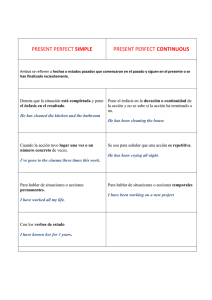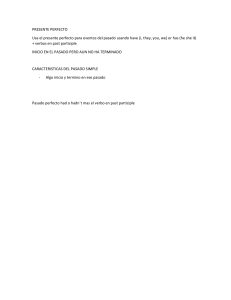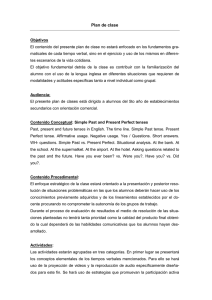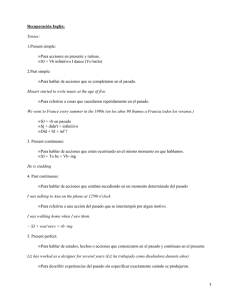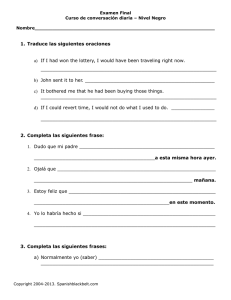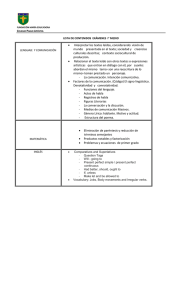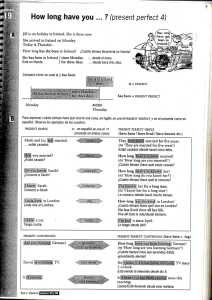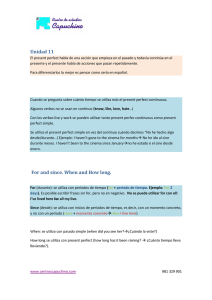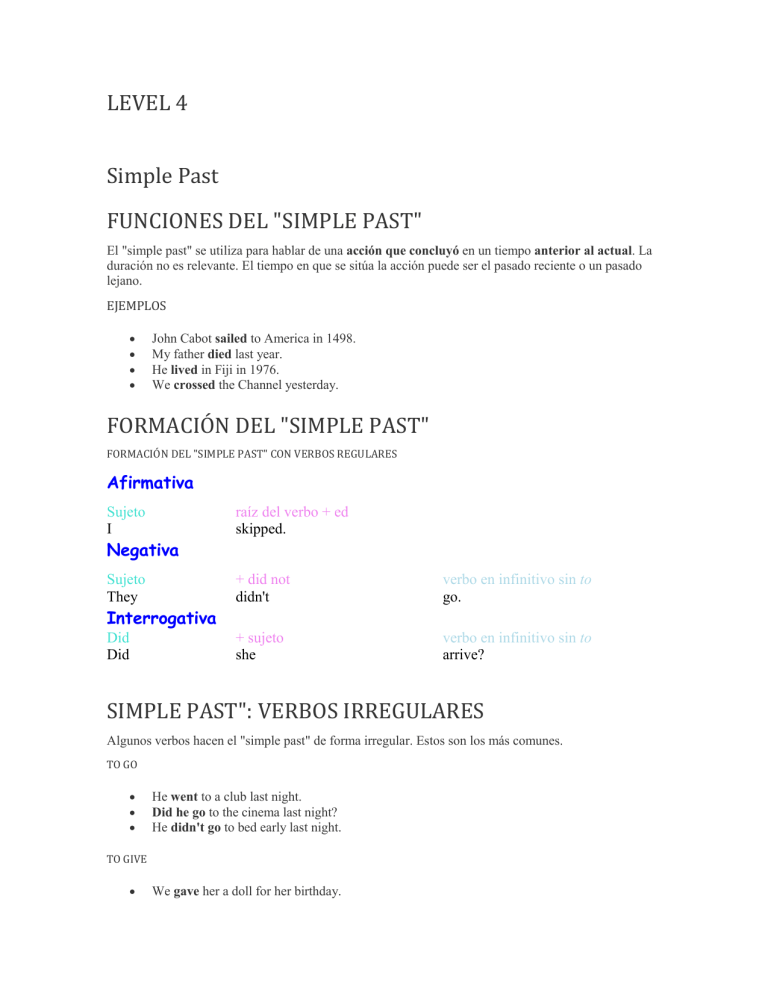
LEVEL 4 Simple Past FUNCIONES DEL "SIMPLE PAST" El "simple past" se utiliza para hablar de una acción que concluyó en un tiempo anterior al actual. La duración no es relevante. El tiempo en que se sitúa la acción puede ser el pasado reciente o un pasado lejano. EJEMPLOS John Cabot sailed to America in 1498. My father died last year. He lived in Fiji in 1976. We crossed the Channel yesterday. FORMACIÓN DEL "SIMPLE PAST" FORMACIÓN DEL "SIMPLE PAST" CON VERBOS REGULARES Afirmativa raíz del verbo + ed skipped. Sujeto I Negativa Sujeto They + did not didn't verbo en infinitivo sin to go. + sujeto she verbo en infinitivo sin to arrive? Interrogativa Did Did SIMPLE PAST": VERBOS IRREGULARES Algunos verbos hacen el "simple past" de forma irregular. Estos son los más comunes. TO GO He went to a club last night. Did he go to the cinema last night? He didn't go to bed early last night. TO GIVE We gave her a doll for her birthday. They didn't give John their new address. Did Barry give you my passport? TO COME My parents came to visit me last July. We didn't come because it was raining. Did he come to your party last week? Notemos que el verbo en pasado sólo lo usamos en oraciones positivas. En las integrrogativas y negativas, el verbo lo usamos en presente porque ya tenemos el auxiliar "DID" en pasado. La gramática con los verbos regulares e irregulares es la misma, recordemos que los regulares van a terminar en "ed" y los irregulares pueden variar en su conjugación: Afirmativa Sujeto I irregular verb in past swam. Negativa Sujeto They + did not didn't verbo en infinitivo sin to swim. + sujeto she verbo en infinitivo sin to swim? Interrogativa Did Did SIMPLE PAST OF BE El pasado simple del verbo to be, tiene las mismas funciones del pasado simple, solo que como ya hemos visto con anterioridad, el verbo to be funciona como auxiliar al mismo tiempo, por ende cuando en una oración negativa e interrogrativa vayamos a utilizar éste verbo no vamos a utilizar verbos auxiliares extras (Did). Éste verbo es irrregular y tiene dos formas en el pasado, una para los pronombres singulares y otra para los plurales: La gramática del pasado simple con el verbo to be es más sencilla, en la forma positiva vamos a usar: Sujeto+ verbo en pasado+ complemento. En la forma negativa: Sujeto+ verbo en pasado+ negación (wasn´t/weren´t)+ complemento. En la forma interrogativa: Verbo en pasado+ sujeto+ complemento. The affirmative form: I, he, she, it you, we, they was. were. Examples: I was in London in 1999. Pam was in London in 1999, too. We were together. She was my girlfriend. The interrogative form: Was Were I, he, she, it? you, we, they? Examples: Were you in London last year? Was Pam with you? Were you together? The negative form: I, he, she, it You, we, they was not. wasn't. were not. weren't. Examples: I wasn't in Paris in 1999. Pam wasn't in Paris in 1999. We weren't in Paris. Use of the simple past The simple past is used principally to describe events in the past. Remember: 1. wasn't is the short form of was not. You can say either: I was not in Paris, or I wasn't in Paris. 2. weren't is the short form of were not. You can say either: we were not in Paris, or we weren't in Paris. You can find more information here: https://www.youtube.com/watch?v=6RedBs8SUhQ https://www.youtube.com/watch?v=ZYTLiP8Y1L4 https://www.youtube.com/watch?v=HOFHkU7qrxA https://www.youtube.com/watch?v=XtQxAcawmtg Present Perfect En general, el presente perfecto es una mezcla entre el presente y el pasado. Lo usamos para acciones en el pasado que tienen importancia en el presente. Se usa el presente perfecto para acciones que ocurrieron en un tiempo no concreto antes de ahora. El tiempo específico no es importante, por lo tanto, no solemos usar expresiones de tiempo específicas (“this morning”, “yesterday”, “last year”…). Se puede usar el presente perfecto con expresiones de tiempo no concretas (“never”, “ever”, “many times”, “for”, “since”, “already”, “yet”…). El presente perfecto equivale más o menos al pretérito perfecto del español, osea nos referimos a una acción ocurrida en el pasado (que pudo haber sucedido varias veces) y que está abierta a la repetición en el presente y/o en el futuro: Yo he ido, Yo he estado, Nosotros hemos caminado, Ella ha visitado...etc. Para formar el presente perfecto vamos a utilizar las dos conjugaciones en presente simple del verbo "to have", que en éste contexto NO significa tener, sino HABER. Y un verbo regular o irregular en pasado participio (Tercera columna de izquierda a derecha en cada clasificación): 1. Affirmative Sentences (Frases afirmativas) Sujeto + verbo auxiliar (to have) + participio pasado… Ejemplos: I have [I’ve] talked to Peter. (He hablado con Peter.) She has [She’s] gone to work. (Ha ido a su trabajo.) We have [We’ve] been to London. (Hemos ido a Londres.) They have [They’ve] learned English. (Han aprendido inglés.) 2. Negative Sentences (Frases negativas) Sujeto + verbo auxiliar (to have) + “not” + participio pasado… Ejemplos: I haven’t talked to Peter. (No he hablado con Peter.) She hasn’t gone to work. (No ha ido a su trabajo.) We haven’t been to London. (No hemos ido a Londres.) They haven’t learned English. (No han aprendido inglés.) 3. Interrogative Sentences (Frases interrogativas) Verbo auxiliar (to have) + sujeto + participio pasado…? Ejemplos: Have you talked to Peter? (¿Has hablado con Peter?) Has she gone to work? (¿Ha ido a su trabajo?) Have you been to London? (¿Has ido a Londres?) Have they learned English? (¿Han aprendido inglés?) We can observe the video to get more information about the topic: https://www.youtube.com/watch?v=N9V48CLLS6g And this one to practice structures and verbs: https://www.youtube.com/watch?v=5Me5AeV6jkk And some extra activities... https://agendaweb.org/exercises/verbs/present-perfect https://agendaweb.org/exercises/verbs/present-perfect-2 https://agendaweb.org/exercises/verbs/present-perfect-multiple https://www.ego4u.com/en/cram-up/grammar/present-perfect-simple/exercises?04 https://www.ego4u.com/en/cram-up/grammar/present-perfect-simple/exercises?05 Since / For / Just Since se utiliza para indicar el principio de un período de tiempo que sigue al presente. Como tal, puede ser traducido como “desde” en español y se usa como un punto de tiempo específico en el pasado. Como este período de tiempo sigue al presente, solemos utilizar “since” con los tiempos perfectos.) (Since, We use since as a preposition, a conjunction and an adverb to refer to a time, and as a conjunction to introduce a reason. We use since to refer back to a previous point in time. We use since as a preposition with a date, a time or a noun phrase: It was the band’s first live performance since May 1990. (since + date) Fue la primera actuación en directo de la banda desde Mayo de 1990. I have been happily married for 26 years, since the age of 21. (since + noun phrase) He estado felizmente casada durante 26 años, desde la edad de 21 We also use since as a conjunction to introduce a subordinate clause: It’s so long since I saw them. (since + clause) Hace tanto tiempo (desde) que no los veo. Lenny had slept most of the way since leaving Texas. (since + clause) Lenny había dormido casi todo el camino desde que salió de Texas. He’s been back to the office a few times since he retired. (since + clause) Él ha vuelto a la oficina un par de veces desde que se retiró Since + -ing We can use since + -ing form to refer to time when the subject of the verb is the same in the main clause and the subordinate clause: (Cuando en la misma cláusula u oración, el verbo es verbo y sujeto al mismo tiempo, éste debe ir con ING) Since leaving school, he has had three or four temporary jobs. (Since he left school, he has …) Desde que salió de la escuela, ha tenido tres o cuatro trabajos temporales. (desde que dejó la escuela...) Since moving from a Chicago suburb to southern California a few months ago, I’ve learned how to play a new game called Lanesmanship. (Since I moved …, I’ve learned …) Desde que me mude de un suburbio de Chicago al sur de California hace unos meses, he aprendido a jugar un nuevo juego llamado Lanesmanship. (desde que me mudé..., he aprendido...) For (For, indica duración o un período de tiempo, así se puede traducir como “durante” en español. No se puede utilizar como “todo”, en el sentido de “todo el día” o “todo el tiempo”. Podemos utilizar “for” con todos los tiempos verbales.) We use for with a period of time to refer to duration (how long something lasts): There’s a lovely open-air pool near us. We usually go there for a couple of hours in the evenings when it’s warm enough. Hay una hermosa piscina al aire libre cerca de nosotros. Normalmente vamos allí por un par de horas en las noches cuando está lo suficientemente caliente. Warning: Don’t confuse for and in when referring to time: We’re going to Cape Town for two months. (We will spend two months in Cape Town.) Vamos a Cape Town por dos meses. (vamos a pasar dos meses en ciudad del cabo.) We’re going to Cape Town in two months. (We’re leaving to go to Cape Town two months from now.) Vamos a Cape Town en dos meses. (nos vamos para ir a ciudad del cabo de dos meses a partir de ahora.) After a negative we can use for and in with the same meaning. In is particularly common in American English: I haven’t seen him in five years. (or for five years.) Just (Just, se utiliza para acciones que han ocurrido hace poco tiempo y se traduce como “acabar de” o “justo”. Al igual que con “already”, “just” va antes del verbo o entre el auxiliar y el verbo en la frase.) Just can mean ‘recently’ or ‘a very short time before or after speaking’: Where’s my phone? I had it just now. ¿Dónde está mi teléfono? Lo tenía justo ahora. Could you wait for me? I’m just going to the shop. ¿Puedes esperarme? Sólo voy a la tienda. We often use the present perfect or past perfect with this meaning of just when we refer to a short time before the moment of speaking: I’ve just decided to sell my apartment. Acabo de decidir vender mi apartamento. I’m on my way to the station. Their train has just arrived. Voy camino a la estación. Su tren acaba de llegar. Ever/never/yet/already/just Hi dear students! Como hemos visto hasta ahora, con el pasado simple podemos utilizar expresiones de tiempo específicas que nos ayudan a ubicar el momento en el cual fueron desarrolladas ciertas acciones, tales como: Yesterday, yesterday morning, two days ago, two months ago, last week, etc. Por otra parte, vimos que con el presente perfecto, podemos utilizar for para expresar periodos de tiempo y since para momentos concretos, sin embargo es importante que aprendamos a utilizar las siguientes partículas que también son bastante comunes e importantes en el uso de éste tiempo: Al usar éstas partículas miremos cuidadosamente su ubicación en las oraciones: Ever, en las preguntas después de have you.../has she... Have you ever been Has she ever met the Prime Minister? to England? Never, se utiliza para hacer una negación (decir que nunca se ha hecho algo), no lo debemos utilizar con estructuras negtivas porque nos quedaría doble negación: I´ve never gone... (después del auxiliar have o has). No: I haven´t never (yo no nunca he...) × I have never been to Italy. I have never eaten Sushi. Yet, solo para oraciones negativas e interrogativas al final de la oración. Have I haven't Has They haven't eaten yet you visited met the Tate he Judy yet? Gallery yet arrived yet? Already, en oraciones positivas después del auxiliar have/has. I've already drunk three coffees this Don't write to John, I've already done it. morning. (= ¡y me estás Just, generalmente en oraciones positivas después del auxiliar have/has. Jane has just made a cake. We´ve just bought a new house. ofreciendo otro!) Past Simple vs Present Perfect Como hemos visto anteriormente en éstos tiempos, hablamos del pasado, pero ¿cómo vamos a utilizar ambos? El presente perfecto nos va a ayudar a expresar una idea general de alguna situación del pasado (no podríamos contar con coherencia una experiencia completa en éste tiempo), y con el pasado simple vamos a especificar los detalles de dicha experiencia: I´ve gone to the U.S.A three times. Last year, I went to Miami and I visited a lot of museums. Uses Present Perfect result of an action in the past is important in the present recently completed actions actions beginning in the past and still continuing together with lately, recently, yet Simple Past action finished in the past series of completed actions in the past together with Past Progressive/Continuous – The Simple Past interrupted an action which was in progress in the past. Simple Past Emphasis on action Present Perfect Simple Emphasis on result Example: I bought a new bike. (just telling what I did in the past.) Example: I have bought a new bike. (With this sentence I actually want to express that I have a new bike now.) Signal Words Simple Past Present Perfect Simple Since for yesterday just ... ago already (two years ago) up to now in 1990 until now / till now the other day ever last ... (not) yet (Last week) so far lately / recently Es muy importante tener presente que con el pasado simple podemos utilizar expresiones de tiempo específicas (para el pasado) y que en el presente perfecto vamos a utilizar expresiones indefinidas como las estudiadas en la lección: Since/for/just. ⇒ Observe how I can combine both tenses to talk about some experiences in the past: The simple past is highlighted with the color green and the present perfect with the color blue. "I think I have had a very interesting life. I'm 73 now and I don't work anymore. I was in the army for 51 years. I retired when I was 69. I have been to so many countries that I can't remember all of them. I've been to Australia six or seven times and to South Africa three times. I have also been once to Russia but I didn't like it at all: much too cold for me! They say that love is the greatest thing and I agree. I've been married four times but never for more than five years. I don't think women really understand me! I've never been on television, but I've been on the radio once. It was a programme about life in the military about twenty years ago. I met the Prime Minister on the same day. Actually, I've met a lot of famous people: members of the royal family, famous politicians and also famous cinema and television personalities. I've never met the American President though which is a pity. Because I've travelled a lot, I've seen a lot of wonderful things and have also eaten and drunk some strange foods and drinks. I ate cat and rat in India and drank something called Mirto on a little island in Italy many years ago." Taken from:http://www.esl-lounge.com/student/grammar/2g30-old-colonel.php Observemos el siguiente video para tener más claridad sobre el tema: https://www.youtube.com/watch?v=ltlJpzq0Nbc Present Perfect Continuous (Present Perfect Progressive). El presente perfecto progresivo o continuo, funciona un poco como el presente perfecto. El muestra una continuidad entre una relación o una acción que comenzó en el pasado y que sigue desarrollando hasta ahora. I have been living here for six years. He estado viviendo aquí desde hace seis años. En esta situación, se puede usar el presente perfecto (I have lived here for six years) para comunicar la misma idea. Sin embargo, el presente perfecto progresivo enfatiza la continuidad en el presente de esos años. En otros casos, el presente perfecto y el presente perfecto progresivo tienen significaciones diferentes. Estoy en un curso de literatura. La maestra hace un pregunta: Has anyone here read Pablo Neruda?¿Hay alguién aquí que ha leído a Pablo Neruda? Leí Viente Poemas de Amor el año pasado entonces levanto la mano y respondo: Yes, I have read a book by Neruda.Sí, he leído un libro de Neruda. Eso quiere decir, por ejemplo, que leí el libro hace un año y no lo he tocado otra vez. Pero si digo: Yes, I have been reading a book by Neruda.Sí, he estado leyendo un libro de Neruda. quiere decir que comencé a leerlo en el pasado, que continuo a leerlo en el presente y que terminaré a leerlo en el futuro. Sigo leyéndolo, no he terminado. Si quiero decir a la profesora que he terminado, necesito el presente perfecto (I have read a book by Neruda) para crear una relación entre un evento del pasado terminado (leí un libro de Neruda) y el evento del presente (estamos hablando de Neruda en este momento). El presente perfecto progresivo a veces se le usa para hacer una pregunta sobre una acción que acaba de terminar Have you been working in the garden? ¿Estabas trabajando en el jardín? Tom acaba de entrar a la casa. En este momento, no esta trabajando en el jardín. Sin embargo, como lleva verduras en sus brazos y su ropa es sucia prefiere utilizar el presente perfecto progresivo para crear un enlace entre el pasado muy recente y el presente. Hemos visto en el primer ejemplo que a veces se puede usar el presente perfecto igual que el presente perfecto progresivo (I have lived here for six years = I have been living here for six years). De manera parecida, a veces se puede usar el presente perfecto progresivo igual que el presente progresivo (I have been reading a book by Pablo Neruda = I am reading a book by Pablo Neruda). La cosa la más importante es de responder a las preguntas con el mismo tiempo y aspecto gramatical. Por ejemplo: question correct answer incorrect answer Yes, she’s been Has she been working? ¿Ha estado trabajando? working. Yes, she is working. Sí, ha estado trabajando. Where has Tom been studying? He has been studying at home. ¿Dónde ha estado estudiando Tom? Ha estado estudiendo en casa. What have you been doing? I have been reading. ¿Qué has estado haciendo? He estado leyendo. He is studying at home. I am reading. GRAMMAR: El presente perfecto progresivo se forma con el presente simple del verbo auxiliar HAVE (have/has), el participio pasado del verbo BE (been) y la forma continua de otro verbo (presente participio) (verb+ing). subject I aux. verb have past part. been present participle (verb+ing) studying English for two years He estado estudiando el inglés desde hace dos años. She has been trying to find a job. working all day. Ha estado tratando de encontrar un trabajo. They have been Han estado trabajando todo el día. You can find more information here: https://www.youtube.com/watch?v=PtUAvPg5i6U&t=9s Present Perfect Continuous and Present Perfect. The present perfect simple suggests completion while the continuous suggests something is unfinished. Present Perfect Simple and Present Perfect Continuous We use the present perfect tense to talk about things where there is a connection between the past and the present. He’s written 16 books. He started writing books at some time in the past. So far, he has written 16 books. He may write more books. As well as the present perfect simple, we can use the present perfect continuous tense to talk about events with a connection to the present. 1 Look at these 2 sentences: I’ve been decorating the house this summer. The focus is on the action – decorating – and the action is unfinished. I’ve painted the living room blue. The focus is on the finished result. The activity is finished but we can see the result now. We use the present perfect continuous when the focus is on an activity that is unfinished. 2 Look at these two sentences. I’ve read that book you lent me. I finished it yesterday. I’ve been reading that book you lent me. I’ve got another 50 pages to read. The present perfect simple (I’ve read) gives the idea of completion while the present perfect continuous (I’ve been reading) suggests that something is unfinished. 3 Look at these two sentences. She’s been writing emails for 3 hours. She’s written 10 messages. The present perfect continuous (has been writing) talks about how long something has been happening. The present perfect simple (has written) talks about how much/how many have been completed. 4 Look at these two sentences. I’ve worked here for thirty years. I usually work in London but I’ve been working in Birmingham for the last 3 weeks. We can use the present perfect simple to talk about how long when we view something as permanent. But the present perfect continuous is often used to show that something is temporary. Past Perfect El "past perfect" hace referencia a un tiempo anterior al pasado reciente. Se emplea para señalar que un evento ocurrió antes que otro en el pasado. No importa cuál de los eventos se mencione primero, porque el tiempo verbal deja claro el orden temporal en que acontecieron. En estos ejemplos, el Evento A es el que primero ocurrió y el Evento B tuvo lugar a continuación, es el más reciente: Evento A John had gone out Evento A I had saved my document Evento B when I arrived in the office. Evento B before the computer crashed. Evento B Evento A When they arrived we had already started cooking. Evento B Evento A He was very tired because he hadn't slept well. GRAMMAR En inglés, el "past perfect" está compuesto por dos partes: el pasado del verbo to have (had) + el "past participle" del verbo principal. Fomar éste tiempo después de haber estudiado el Present Perfect nos puede resutar un poco mas fácil ya que la gramática funciona de la misma manera, "have" va a seguir siendo nuestro verbo auxiliar, pero en este caso va a tener solo una conjugación en pasado que nos sirve para todos los pronombres personales y el verbo principal va a estar conjugado en pasado participio. Sujeto had past participle Afirmativa She had given hadn't asked. they arrived? you finished? Negativa She Interrogativa Had Interrogativa negativa Hadn't PAST PERFECT EXAMPLE Afirmativa Negativa Interrogativa I had decided I hadn't decided Had I decided? You had decided You hadn't decided Had you decided? Afirmativa Negativa Interrogativa She had decided She hadn't decided Had she decided? We had decided We hadn't decided Had we decided? They had decided They hadn't decided Had they decided? This video could help us to solve some doubts: https://www.youtube.com/watch?v=PQ6s89XUvz4 Past Perfect Continuous El "past perfect continuous" se corresponde con el "present perfect continuous" pero se refiere a un tiempo anterior al pasado reciente. Como ocurre con el "present perfect continuous", nos interesa más el proceso que el resultado. EXAMPLES Had you been waiting long before the taxi arrived? We had been trying to open the door for five minutes when Jane found her key. It had been raining hard for several hours and the streets were very wet. Her friends had been thinking of calling the police when she walked in. GRAMMAR El "past perfect continuous" está compuesto por dos elementos: el "past perfect" del verbo to be (=had been) + el "present participle" del verbo principal (raíz+ing). Como lo estudiamos en el Present Perfect Progressive (continuous), aquí vamos a utilizar el auxiliar have, en pasado que el es mismo para todos los pronombres personales (had), + el pasado participio del verbo to be (BEEN) + un verbo principal con la terminación "ING". Sujeto had been raíz + ing walkin g I had been Afirmativa She had been trying hadn't been sleepi ng Had you been eating ? Interrogativa negativa Hadn't they been living? Negativa She Interrogativa PAST PERFECT CONTINUOUS EXAMPLES Afirmativa I had been buying You had been buying She had been buying We had been buying Negativa I hadn't been buying You hadn't been buying She hadn't been buying We hadn't been buying They had been buying They hadn't been buying Interrogativa Had I been buying? Had you been buying? Had she been buying? Had we been buying? Had they been buying? Find more information here: https://www.youtube.com/watch?v=w4VKstoLUrg Conditionals CONDITIONALS Los condicionales se emplean para especular acerca de lo que podría ocurrir, lo que puede haber ocurrido y lo que desearíamos que ocurriese. En inglés, la mayoría de las oraciones que emplean el tiempo verbal condicional contienen el término "if". Muchas de las construcciones condicionales del inglés se utilizan en oraciones que incluyen verbos en pasado. Este uso se denomina "el pasado irreal" porque empleamos un tiempo verbal de pasado pero no estamos refiriéndonos a algo que haya sucedido realmente. Hay cinco formas principales de construir oraciones condicionales en inglés. En todos los casos, se componen de una proposición o cláusula con "if" y una proposición principal. En muchas oraciones condicionales negativas existe una construcción alternativa equivalente que usa "unless" en lugar de "if". Por ahora vamos a estudiar las formas condicionales básicas, las cuales podemos seguir ampliando en el transcurso de los estudios que hagamos del idioma. ZERO CONDITIONAL El "zero conditional" se utiliza cuando el tiempo al que nos referimos es ahora o siempre y la situación es real y posible. Este tipo de condicional suele emplearse para hablar de hechos generales. El tiempo verbal de ambas proposiciones es el "simple present". En las oraciones condicionales de tipo 0, el término "if" puede normalmente sustituirse por "when" sin que cambie el significado. Examples: If people eat too much, they get fat. (Si las personas comen mucho, se engordan). If you touch a fire, you get burned. (Si tocas el fuego, te quemas) People die if they don't eat. (Las personas mueren si no comen) You get water if you mix hydrogen and oxygen. (Consigues agua si mezclas hidrógeno y oxígeno) Snakes bite if they are scared. (Las serpientes muerden si están asustadas) If babies are hungry, they cry. (Si los bebés tienen hambre, lloran). FIRST CONDITIONAL El "type 1 conditional" se emplea para referirse al presente o futuro cuando la situación es real. El condicional tipo 1 se refiere a una condición posible y su resultado probable. En estas oraciones, la cláusula "if" adopta el "simple present" y la proposición principal el "simple future" (Will). Examples: If it rains, I won't go to the park. (Si llueve, no iré al parque) If I study today, I'll go to the party tonight. (Si estudio hoy, iré a la fiesta ésta noche) If I have enough money, I'll buy some new shoes. (Si tengo sufciente dinero, compraré unos zapatos nuevos) She'll be late if the train is delayed. (Ella llegará tarde, si el tren se retraza). She'll miss the bus if she doesn't leave soon. (Ella perderá el bus si no se va pronto). If I see her, I'll tell her. (Si la veo, le diré). SECOND CONDITIONAL El "type 2 conditional" se utiliza para referirse a un tiempo que puede ser ahora o en cualquier momento y a una situación que no es real. Estas oraciones no aluden a hechos. El condicional tipo 2 se emplea para hacer referencia a una condición hipotética y su resultado probable. En estas oraciones, la proposición "if" adopta el "simple past" y la cláusula principal el "present conditional" (estructura con WOULD). Examples: If I won the lottery, I would buy a big house.(I probably won't win the lottery) (Si ganara la lotería, compraría una casa grande). If I met the Queen of England, I would say hello. (Si conociera a la reina de Inglaterra, le diría hola (la saludaría)). She would travel all over the world if she were rich. (Ella viajaría al rededor del mundo si fuera rica). She would pass the exam if she ever studied.(She never studies, so this won't happen) (Ella pasaría el exámen si estudiara). THIRD CONDITIONAL El "type 3 conditional" se emplea para referirse a un tiempo situado en el pasado y a una situación contraria a la realidad. Se basa en unos hechos que son opuestos a lo que se está expresando. El condicional tipo 3 se utiliza para hacer referencia a una condición del pasado que no es real, así como a su resultado probable en el pasado. En estas oraciones, la cláusula "if" adopta el "past perfect" y la proposición principal el "perfect conditional". We make the third conditional by using the past perfect after 'if' and then 'would have' and the past participle in the second part of the sentence: if + past perfect, ...would + have + past participle En la cláusula que contiene la partícula "if" ,vamos a utilizar el pasado del verbo "have" para formar le pasado pefecto: If+Subject+HAD+verb in past participle. En la cláusula principal, siempre vamos a usar la estructura: Subject+ WOULD HAVE+ verb in past participle. It talks about the past. It's used to describe a situation that didn't happen, and to imagine the result of this situation. Examples: If she had studied, she would have passed the exam (but, really we know she didn't study and so she didn't pass) (Si ella hubiese estudiado, habría pasado el exámen). If I hadn't eaten so much, I wouldn't have felt sick (but I did eat a lot, and so I did feel sick). (Si no hubiese comido tanto, no habría enfermado). If we had taken a taxi, we wouldn't have missed the plane (Si hubiésemos tomado un taxi, no habríamos perdido el avión). She wouldn't have been tired if she had gone to bed earlier. (Ella no habría estado cansada si hubiese ido temprano a la cama). She would have become a teacher if she had gone to university. (Ella se habría vuelto una profesora si hubiese ido a la universidad). He would have been on time for the interview if he had left the house at nine. (El habría llegado a tiempo a la entrevista si hubiese dejado la casa a las 9). Observemos que en los ejemplos anteriores, se puede cambiar el orden de las cláusulas (puede ir la oración con "if" al principio o en el segundo lugar) siempre y cuando ésta tenga coherencia y que debemos conjugar los verbos según el sujeto de cada cláusula. Aquí tenemos una tabla con un resúmen fácil de las estructuras de los condicionales, también podemos observar el siguiente video que nos puede ayudar a comprender mejor los conceptos y usos de los condicionales. https://www.youtube.com/watch?v=OyxF4grou0Y
